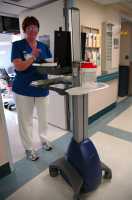Author Interviews, BMJ, Global Health, Pediatrics / 07.11.2018
Female Genital Mutilation of Young Girls Declines in Africa, Not in Western Asia
MedicalResearch.com Interview with:
 Professor Ngianga-Bakwin Kandala
Professor of Biostatistics
Department: Mathematics, Physics and Electrical Engineering
Northumbria University, UK
MedicalResearch.com: What is the background for this study? What are the main findings?
Response: The background “UNICEF (2014) estimates that worldwide more than two hundred million women have undergone some form of FGM/C, and approximately 3.3 million girls are cut each year. Recent estimates show that if FGM/C practices continue at current, 68 million girls will be cut between 2015 and 2030 in 25 countries where FGM is routinely practiced and more recent data are available (UNJP, 2018).”
Main findings: The prevalence of FGM/C among children varied greatly between countries and regions and also within countries over the survey periods. We found evidence of significant decline in the prevalence of FGM/C in the last three decades among children aged 0–14 years in most of the countries and regions, particularly in East, North and West Africa. We show that the picture looks different in Western Asia, where the practice remains and affects the same age group.
(more…)
Professor Ngianga-Bakwin Kandala
Professor of Biostatistics
Department: Mathematics, Physics and Electrical Engineering
Northumbria University, UK
MedicalResearch.com: What is the background for this study? What are the main findings?
Response: The background “UNICEF (2014) estimates that worldwide more than two hundred million women have undergone some form of FGM/C, and approximately 3.3 million girls are cut each year. Recent estimates show that if FGM/C practices continue at current, 68 million girls will be cut between 2015 and 2030 in 25 countries where FGM is routinely practiced and more recent data are available (UNJP, 2018).”
Main findings: The prevalence of FGM/C among children varied greatly between countries and regions and also within countries over the survey periods. We found evidence of significant decline in the prevalence of FGM/C in the last three decades among children aged 0–14 years in most of the countries and regions, particularly in East, North and West Africa. We show that the picture looks different in Western Asia, where the practice remains and affects the same age group.
(more…)
 Professor Ngianga-Bakwin Kandala
Professor of Biostatistics
Department: Mathematics, Physics and Electrical Engineering
Northumbria University, UK
MedicalResearch.com: What is the background for this study? What are the main findings?
Response: The background “UNICEF (2014) estimates that worldwide more than two hundred million women have undergone some form of FGM/C, and approximately 3.3 million girls are cut each year. Recent estimates show that if FGM/C practices continue at current, 68 million girls will be cut between 2015 and 2030 in 25 countries where FGM is routinely practiced and more recent data are available (UNJP, 2018).”
Main findings: The prevalence of FGM/C among children varied greatly between countries and regions and also within countries over the survey periods. We found evidence of significant decline in the prevalence of FGM/C in the last three decades among children aged 0–14 years in most of the countries and regions, particularly in East, North and West Africa. We show that the picture looks different in Western Asia, where the practice remains and affects the same age group.
(more…)
Professor Ngianga-Bakwin Kandala
Professor of Biostatistics
Department: Mathematics, Physics and Electrical Engineering
Northumbria University, UK
MedicalResearch.com: What is the background for this study? What are the main findings?
Response: The background “UNICEF (2014) estimates that worldwide more than two hundred million women have undergone some form of FGM/C, and approximately 3.3 million girls are cut each year. Recent estimates show that if FGM/C practices continue at current, 68 million girls will be cut between 2015 and 2030 in 25 countries where FGM is routinely practiced and more recent data are available (UNJP, 2018).”
Main findings: The prevalence of FGM/C among children varied greatly between countries and regions and also within countries over the survey periods. We found evidence of significant decline in the prevalence of FGM/C in the last three decades among children aged 0–14 years in most of the countries and regions, particularly in East, North and West Africa. We show that the picture looks different in Western Asia, where the practice remains and affects the same age group.
(more…)


























